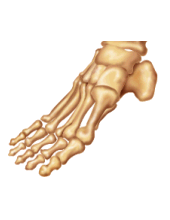The Foot consists of a number of bones, ligaments and muscles bound together in such a way that they not only provide a platform which bears our weight, it also allows us to walk over rough uneven ground without losing balance. The bones consist of the seven bones, called tarsal bones, which make up the ankle and the heel, the five long metatarsal bones that form the back of the foot, each of which joins to a toe, and those of the toes themselves, called phalanges - the big toe has two and the other toes have three. The arrangement of the bones and the ligaments are such that the foot has two arches running along it from back to front, one on the inside of the foot, called the medial longitudinal arch, and one on the outside call the lateral longitudinal arch, together with one running from side to side, just before the toes, called the transverse arch. (You can see where these arches are in a footprint of a bare foot - it's the places where there isn't a mark). The function of the arches is to allow the foot to absorb the weight when we’re standing still - the bones are locked together and the ligaments are tight - while allowing movement and flexibility when we’re walking or running: the ligaments relax and the bones can move relative to each other allowing, for example, the foot to turn inwards or outwards. Each joint where bones come into contact with each other has its own synovial capsule. Movements of the joints and the toes are controlled by muscles in the leg, such as the peroneous muscles which act through tendons running in the sole of the foot, and small muscles in the foot itself. There is a large layer of tough tissue, called fascia, running down the centre of the sole of the foot, forming what is called the plantar aponeurosis - it's this that stops the arches of the foot collapsing when we are standing still.
|

